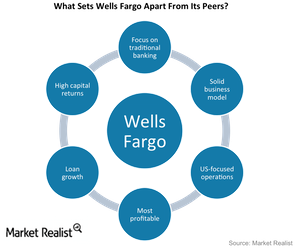Wells Fargo: What Sets It Apart from Its Peers?
Wells Fargo (WFC) is the largest mortgage lender in the US, operating primarily as a retail and commercial bank. It is been the most profitable bank in its peer group, posting a return of 10% on shareholder’s equity and ~1.3% on assets in 2015.
July 1 2016, Updated 8:56 a.m. ET

Wells Fargo: The most profitable bank
Wells Fargo (WFC) is the largest mortgage lender in the US, operating primarily as a retail and commercial bank (KBE) (VFH).
Unlike its peers, Wells Fargo has little exposure to trading and investment banking operations. Its income is primarily derived from the traditional loan-making business. It is also Warren Buffett’s largest holding.
Wells Fargo’s book value has grown twice that of JPMorgan Chase and is ten times that of Bank of America (BAC) in the past ten years. It has been one of the most profitable banks in America, generating an ~1.3% return on assets in 2015.
It is the third largest bank in the United States by assets, and it is the second largest in terms of deposits, home mortgage servicing, and debit cards. Its main competitors in the United States are JPMorgan Chase (JPM), Bank of America (BAC), and Citigroup (C).
Focus on traditional banking
Wells Fargo (WFC) focuses primarily on traditional banking operations such as providing loans and generating deposits. Its relatively simple operating model makes it less risky than its peers JPMorgan Chase (JPM), Goldman Sachs (GS), and Citigroup (C), which engage in more complex and riskier activities such as trading and investment banking.
US-focused operations
Wells Fargo’s operations and investments are more US-focused than its large-cap peers. Consequently, it is less sensitive to global events than its peers.
In 4Q15, its non-US exposure accounted for 4.4% of its total assets. In comparison, for Citigroup (C), JPMorgan Chase, and Bank of America, this ratio stood at 52.3%, 11.4% and 10.9%, respectively.
